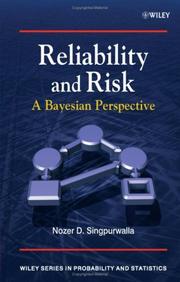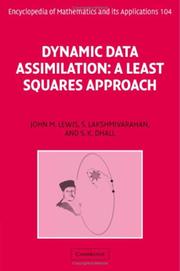| Listing 1 - 10 of 41 | << page >> |
Sort by
|

ISBN: 9781860946509 186094650X Year: 2006 Publisher: London : Hackensack : Imperial College Press World Scientific,
Abstract | Keywords | Export | Availability | Bookmark
 Loading...
Loading...Choose an application
- Reference Manager
- EndNote
- RefWorks (Direct export to RefWorks)
Turbulence --- Mathematical models. --- Modèles mathématiques --- Modèles mathématiques

ISBN: 1580539076 Year: 2006 Publisher: Boston, MA : Artech House,
Abstract | Keywords | Export | Availability | Bookmark
 Loading...
Loading...Choose an application
- Reference Manager
- EndNote
- RefWorks (Direct export to RefWorks)
Electromagnetic fields --- Microwave circuits --- Antennas (Electronics) --- Champs électromagnétiques --- Circuits pour micro-ondes --- Antennes (Electronique) --- Mathematical models --- Mathematical models --- Mathematical models. --- Modèles mathématiques --- Modèles mathématiques --- Modèles mathématiques

ISBN: 9780470855027 0470855029 Year: 2006 Publisher: New York : J. Wiley & Sons,
Abstract | Keywords | Export | Availability | Bookmark
 Loading...
Loading...Choose an application
- Reference Manager
- EndNote
- RefWorks (Direct export to RefWorks)
Reliability (Engineering) --- Risk management --- Bayesian statistical decision theory. --- Fiabilité --- Gestion du risque --- Statistique bayésienne --- Mathematical models. --- Mathematical models. --- Modèles mathématiques --- Modèles mathématiques
Book
ISBN: 2746214415 Year: 2006 Publisher: Paris : Hermès science publications,
Abstract | Keywords | Export | Availability | Bookmark
 Loading...
Loading...Choose an application
- Reference Manager
- EndNote
- RefWorks (Direct export to RefWorks)
Rheology --- Building materials --- Rhéologie --- Construction --- Mathematical models --- Matériaux --- Modèles mathématiques

ISBN: 9780674023383 0674023382 Year: 2006 Publisher: Cambridge, Mass. : Belknap Press of Harvard University Press,
Abstract | Keywords | Export | Availability | Bookmark
 Loading...
Loading...Choose an application
- Reference Manager
- EndNote
- RefWorks (Direct export to RefWorks)
Evolution (Biology) --- Evolution (Biologie) --- Mathematical models --- Modèles mathématiques --- Mathematical models. --- Modèles mathématiques --- Évolution (biologie) --- Modèles mathématiques. --- Evolution (Biology) - Mathematical models --- Évolution (biologie) --- Modèles mathématiques.
Book
ISBN: 2707148830 9782707148834 Year: 2006 Volume: 451 Publisher: Paris: La Découverte,
Abstract | Keywords | Export | Availability | Bookmark
 Loading...
Loading...Choose an application
- Reference Manager
- EndNote
- RefWorks (Direct export to RefWorks)
Suggéré par une expérience menée en 1950 par les mathématiciens Melvin Dresher et Merrill Flood, puis explicité la même année par leur collègue Albert Tucker, le dilemme du prisonnier s'est imposé comme un modèle de référence en économie et en sciences sociales, mais aussi en biologie. L'objet de ce livre est de présenter les avancées les plus récentes des recherches sur le dilemme du prisonnier et ses généralisations (jeu du bien public, jeu de la ressource commune, jeux de confiance). Il expose comment le dilemme du prisonnier est aujourd'hui mobilisé par les économistes, mais aussi par certains sociologues, psychologues, anthropologues ou encore biologistes, comme outil d'analyse de la coopération, de la confiance, de la loyauté, donc du lien social. D'un abord simple et didactique, ce livre ne nécessite aucun prérequis (ni en mathématiques ni en économie) et s'adresse à tous ceux qui veulent connaître les travaux scientifiques récents sur ces questions.
Economics --- Econometric models --- Mathematical models --- Economie politique --- Modèles économétriques --- Modèles mathématiques --- Modèles économétriques --- Modèles mathématiques

ISBN: 2880746485 9782880746483 Year: 2006 Publisher: Lausanne : Antony : Presses polytechniques et universitaires romandes Cemagref,
Abstract | Keywords | Export | Availability | Bookmark
 Loading...
Loading...Choose an application
- Reference Manager
- EndNote
- RefWorks (Direct export to RefWorks)
Avalanches --- Snow mechanics --- Mathematical models --- Avalanches. --- Snow mechanics. --- Mathematical models. --- Avalanches - Mathematical models --- Neige, mécanique de la --- Modèles mathématiques
Book
Year: 2006 Publisher: Cambridge ; New York : Cambridge University Press,
Abstract | Keywords | Export | Availability | Bookmark
 Loading...
Loading...Choose an application
- Reference Manager
- EndNote
- RefWorks (Direct export to RefWorks)
Mathematics --- Social sciences --- Mathématiques --- Sciences sociales --- Study and teaching (Higher) --- Mathematical models. --- Etude et enseignement (Supérieur) --- Modèles mathématiques

ISBN: 9780521851558 0521851556 9780511526480 9781461941507 1461941504 0511526482 9781107390423 1107390427 1139883232 1107383994 1107387507 1107398835 1107395224 Year: 2006 Volume: 104 Publisher: Cambridge
Abstract | Keywords | Export | Availability | Bookmark
 Loading...
Loading...Choose an application
- Reference Manager
- EndNote
- RefWorks (Direct export to RefWorks)
Dynamic data assimilation is the assessment, combination and synthesis of observational data, scientific laws and mathematical models to determine the state of a complex physical system, for instance as a preliminary step in making predictions about the system's behaviour. The topic has assumed increasing importance in fields such as numerical weather prediction where conscientious efforts are being made to extend the term of reliable weather forecasts beyond the few days that are presently feasible. This book is designed to be a basic one-stop reference for graduate students and researchers. It is based on graduate courses taught over a decade to mathematicians, scientists, and engineers, and its modular structure accommodates the various audience requirements. Thus Part I is a broad introduction to the history, development and philosophy of data assimilation, illustrated by examples; Part II considers the classical, static approaches, both linear and nonlinear; and Part III describes computational techniques. Parts IV to VII are concerned with how statistical and dynamic ideas can be incorporated into the classical framework. Key themes covered here include estimation theory, stochastic and dynamic models, and sequential filtering. The final part addresses the predictability of dynamical systems. Chapters end with a section that provides pointers to the literature, and a set of exercises with instructive hints.
Simulation methods --- Mathematical models --- Simulation, Méthodes de --- Modèles mathématiques --- Méthodes de simulation --- Méthodes de simulation --- Modèles mathématiques --- Simulation methods. --- Mathematical models. --- Models, Mathematical --- Simulation techniques --- System simulation --- Operations research --- Systems engineering --- Models and modelmaking

ISBN: 9780123735522 0123735521 1493300989 9786610707690 1280707690 0080465706 9780080465708 Year: 2006 Publisher: Oxford : Academic,
Abstract | Keywords | Export | Availability | Bookmark
 Loading...
Loading...Choose an application
- Reference Manager
- EndNote
- RefWorks (Direct export to RefWorks)
Everyone makes decisions, but not everyone is a decision analyst. A decision analyst uses quantitative models and computational methods to formulate decision algorithms, assess decision performance, identify and evaluate options, determine trade-offs and risks, evaluate strategies for investigation, and so on. This book is written for decision analysts. The term ""decision analyst"" covers an extremely broad range of practitioners. Virtually all engineers involved in design (of buildings, machines, processes, etc.) or analysis (of safety, reliability, feasibility, etc.) are decision analys
Decision making --- Uncertainty --- Risk assessment --- Prise de décision --- Incertitude --- Evaluation du risque --- Mathematical models --- Modèles mathématiques --- Uncertainty. --- Mathematical models. --- Prise de décision --- Modèles mathématiques --- ELSEVIER-B EPUB-LIV-FT --- Reasoning
| Listing 1 - 10 of 41 | << page >> |
Sort by
|

 Search
Search Feedback
Feedback About UniCat
About UniCat  Help
Help News
News